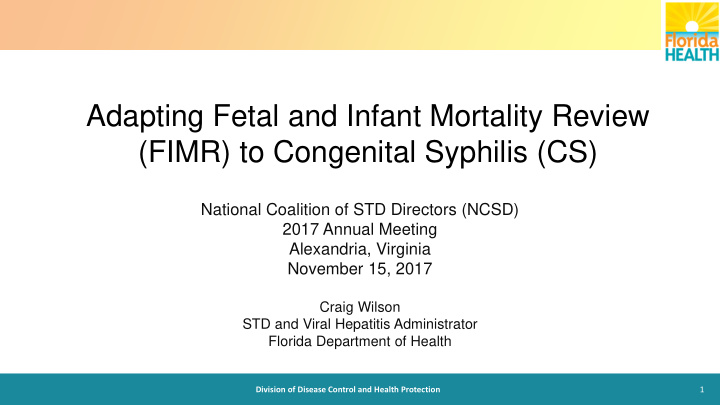



Adapting Fetal and Infant Mortality Review (FIMR) to Congenital Syphilis (CS) National Coalition of STD Directors (NCSD) 2017 Annual Meeting Alexandria, Virginia November 15, 2017 Craig Wilson STD and Viral Hepatitis Administrator Florida Department of Health Division of Disease Control and Health Protection 1
Learning Objectives • Understanding the need for additional is CS data • History and construct of FIMR • Healthy Start Program in Florida • Supplemental grant activities Division of Disease Control and Health Protection 2
Currently Collected – Maternal • Contact and demographic data • Pregnancy history, last menstrual period, estimated date of delivery, prenatal visit data • Syphilis and HIV testing history and diagnoses • Treatment and serologic response Division of Disease Control and Health Protection 3
Currently Collected - Baby • Delivery – date, weight, vital status, gestational age • Testing data – type(s), source, date, results • Symptoms – long bone, cerebrospinal fluid, venereal disease research laboratory test or white blood cell, other • Treatment • Congenital record created whether or not morbidity claimed Division of Disease Control and Health Protection 4
Data Collection Gaps • Barriers to prenatal care • Social services agencies’ involvement • Cultural beliefs • Many current data fields are not required • Missing pregnancy status Division of Disease Control and Health Protection 5
FIMR Roots • Infant mortality considered proxy for health of communities • US infant mortality rate in 1989 was 9.7/1,000 live births • Ranked 19 of 25 industrialized countries (range 4.4–14.4) • Racial and ethnic disparities: 1989–91 African American babies 2.4 times more likely than Caucasian babies to die in first year • Early discussions around social determinants of health Division of Disease Control and Health Protection 6
FIMR and Healthy Start in Florida • National American Congress of Obstetricians and Gynecologists initiative begun around 1990 to address infant mortality rates • Broward County, Florida among first 12 projects funded nationally • Florida established Healthy Start in 1991 to improve birth and developmental outcomes; included local coalitions to assess community needs, system of care • Healthy Start funded with state general revenue and Maternal and Child Health Federal Block grant • 12 FIMR projects currently (11 funded) Division of Disease Control and Health Protection 7
Elements of FIMR • Selection process: all, randomized, conditional • Data extraction: family interviews, birth/death certificates, autopsy reports, hospital records, outpatient records, other service providers • Case review team: consumers, array of professionals • Community action team: politically savvy, gatekeepers • Evaluation Division of Disease Control and Health Protection 8
FIMR Process for Improvement Death Occurs Cases Selected Data Abstracted Case Review Team Reviews and Recommends Community Action Team Proposes Community Action Improved Health Division of Disease Control and Health Protection 9
Syphilis in Women versus Congenital Syphilis 1600 70 Number of Congenital Cases 1400 Number of Female Cases 60 60 48 1200 50 1000 40 800 39 38 35 30 600 20 400 10 200 0 0 2012 2013 2014 2015 2016 Females with Syphilis Congenital Syphilis Division of Disease Control and Health Protection 10
FIMR Process for Congenital Syphilis • Contract with Florida Association of Healthy Start Coalitions • Directly funding five counties with largest number of CS cases in 2016 (44/60 cases) • Review process to be replicated statewide • Review ≥90% of reported cases • Case Review Team: consumers, professionals including Healthy Start representative, social worker, Sexually Transmitted Diseases Program member, medical professionals Division of Disease Control and Health Protection 11
FIMR Process for Congenital Syphilis, continued • Confidentiality statements required • Data sources: – Mothers’ medical records – Baby’s medical records – Delivery facility records – Records from all involved social service agencies – Interview with mother – Surveillance records Division of Disease Control and Health Protection 12
FIMR Process for Congenital Syphilis, continued • Missed opportunities • Service gaps • Barriers/contributing factors: – Transportation – Insurance – Cultural beliefs – Prenatal testing Division of Disease Control and Health Protection 13
Anticipated Outcomes • More complete epidemiologic profile of CS cases • Improved coordination of case prevention effort • More targeted education campaign for providers • Identified needs addressed via local community planning processes Division of Disease Control and Health Protection 14
Questions and Discussion Craig Wilson STD and Viral Hepatitis Administrator Florida Department of Health Craig.Wilson@flhealth.gov 850-245-4602 Division of Disease Control and Health Protection 15
Recommend
More recommend